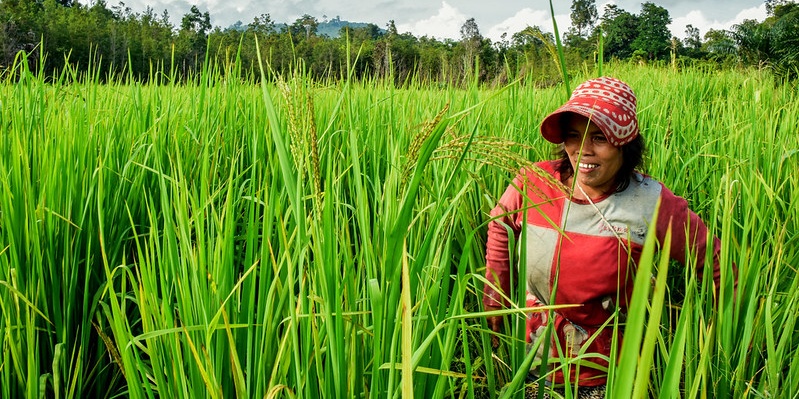
In June 2021, on the margins of World Environment Day, the United Nations Environment Programme (UNEP) and partners launched the Transformative Partnership Platform on agroecology – a farming approach that’s inspired by natural ecosystems combines local and scientific knowledge and focuses on the interactions between plants, animals, humans and the environment.
Over decades, as populations have grown, more people are consuming – and wasting more food – than ever before. Unsustainable food production and consumption patterns are a common thread, running through many of the greatest challenges facing humanity today.
Between 2000 and 2010, large-scale commercial agriculture accounted for 40 per cent of tropical deforestation; and local subsistence agriculture was not far behind, accounting for another 33 per cent. But human food systems depend on biodiversity to function, and conventional food systems reduce biodiversity – effectively destroying their own foundation.
Over the past 100 years, more than 90 per cent of crop varieties have disappeared and today, just nine plant species account for 66 per cent of total crop production – contributing to ubiquitous health risks like diabetes, obesity and malnutrition.
Intensive farming also plays a role in the emergence of zoonotic diseases such as COVID-19. Clearing space for agriculture can reduce the natural buffers that protect humans from viruses and other pathogens circulating among wildlife. And pathogens spread even more easily among intensively-farmed flocks and herds with genetic similarities – particularly when they are kept in close proximity.
At the same time, antimicrobials are often used to accelerate livestock growth, can lead to resistance in microorganisms – making antimicrobials less effective as medicine for humans. Currently, about 700,000 people die of resistant infections every year and by 2050, those diseases may cause more deaths than cancer.
Add to all of this the fact that our food systems account for a quarter of all man-made greenhouse gas emissions. According to the World Economic Forum, biodiversity loss and ecosystem collapse rank among the top five threats to humanity in the next ten years.
Nonetheless, the world spends about 1 million dollars to subsidize agriculture, every single minute.
Transformative change
The demand for food is projected to increase by 60 per cent by 2050. This means that the decisions we make today will have an enormous impact on food security and, by extension, on the environment, economy, health, education, peace and human rights.
Specifically, the global food system must be transformed to achieve two purposes. Firstly, it must ensure food and nutritional security and put an end to hunger, once and for all. Secondly, it must reverse the degradation that human actions have caused and restore ecosystems.
The IIASA-ISC report argues that the emphasis on efficiency, which has been driving to a large part the evolution of food systems, needs to be counter-balanced by a greater emphasis on resilience and equity concerns. As illustrated by the pandemic this entails expanding the scope and reach of social safety nets and protection schemes. It also includes assessing and where necessary adjusting supply chains and trade in their capacity to absorb and adapt to a multitude of risks
Agroecological farming
Agroecology (also referred to as ecological or regenerative agriculture) is one of the most effective ways to make food systems more sustainable; and to build a safer, cleaner, more inclusive post-COVID world. By drawing on natural processes like biological nitrogen fixation, biodiversity and recycling – rather than chemicals, which reduce biodiversity and contribute to climate change – it challenges the ‘business as usual’ agricultural model.
Agroecology is instrumental for realizing 12 of the 17 Sustainable Development Goals, including the reduction of poverty and hunger; and, because it requires fewer external inputs and shortens value chains, agroecology empowers farmers and local communities. It is part of a holistic response to some of the greatest challenges to planetary health – helping to cut waste, reduce emissions and stop the pollution of natural environments. And according to a review of findings from over the past decade, agroecological crop protection also reduces the risks of the emergence of viral zoonoses.
UNEP and agroecology
The Transformative Partnership Platform (TPP) on agroecology is composed of the ICRAF, CIRAD, Biovision, CIFOR, Food and Agriculture Organization (FAO), TMG Think Tank for Sustainability and UNEP. Coordinating at international, national and local levels, the partnership connects research and development, science, social movements and local knowledge, to inform donors and policy makers, and foster innovation.
With a view to empower people to advocate for an agroecological transformation of food systems, a memorandum of understanding between UNEP and Biovision (effective 4 June) will facilitate cooperation in private sector development, policy exchanges, and multi-stakeholder dialogues.
UN Food Systems Summit
In September 2021, UN Secretary-General, António Guterres will convene the UN Food Systems Summit. Recognizing that food systems are one of the main reasons we are failing to stay within the planet’s ecological boundaries, the Summit aspires to nothing less than sweeping global transformation. It is both an important component of the Decade on Ecosystem Restoration and critical to the achievement of goals encompassed by Agenda 2030.
Raising awareness, stimulating discussion and identifying solutions, the Summit calls for actions from governments, businesses and citizens – at every level and throughout every sector of society. Policies must prioritize regenerative agriculture and the restoration of degraded land. Subsidies must be redirected from traditional to sustainable and regenerative agriculture. Consumers must demand more of producers, and citizens must hold governments to account.
For more information, contact:
UNEP Head of Biodiversity and Land Management Branch, Doreen Robinson: [email protected]
UNEP Programme Management Officer and lead agroecology focal point, Siham Drissi: [email protected]
Photo by Icaro Cooke Vieira/CIFOR